- Home
- Users & Science
- Scientific Documentation
- ESRF Highlights
- ESRF Highlights 2015
- Facts and Figures
Facts and Figures
Members and associate countries
(as of JANUARY 2016)
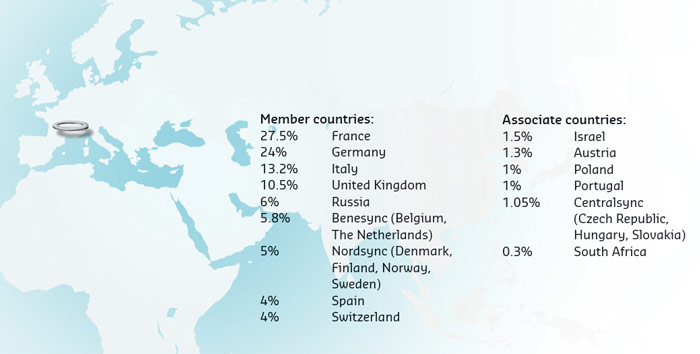 |
|
|
The beamlines
Details of the public ESRF beamlines as well as those operated by Collaborating Research Groups (CRG) are given in Tables 5 and 6. Figure 162 shows the location of the beamlines in the experimental halls.
 |
|
Fig. 162: Experimental hall showing location of the beamlines (public and CRG beamlines). |
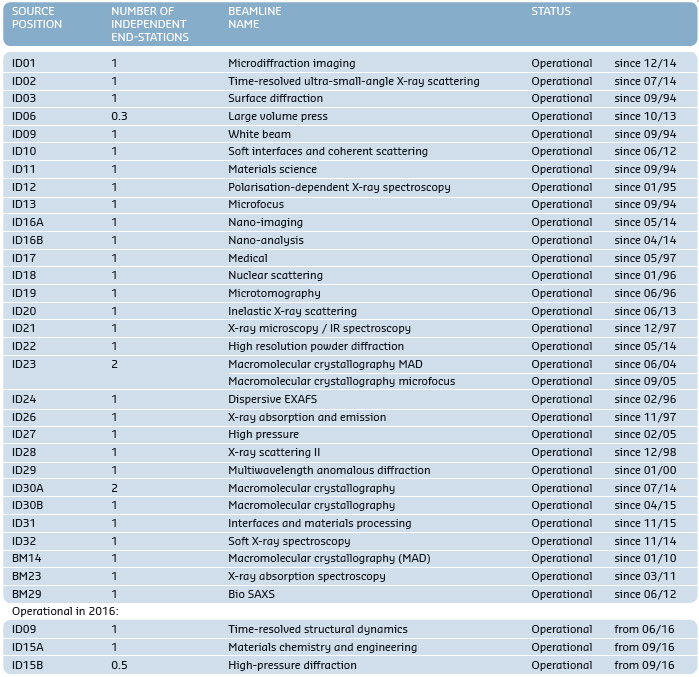 |
|
Table 5: List of the ESRF public beamlines. |
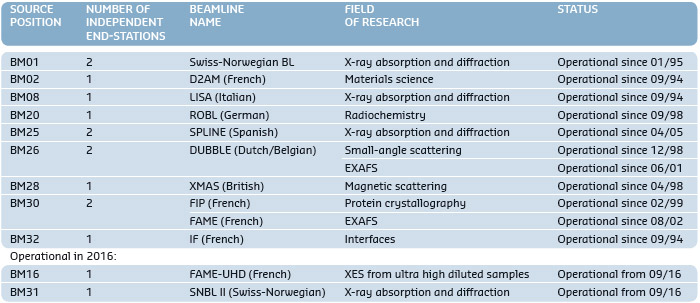 |
|
Table 6: List of the Collaborating Research Group beamlines. |
User Operation
User operation at the ESRF during 2015 saw the successful culmination of Phase I of the Upgrade Programme, which began back in 2009, with all remaining upgrade beamlines except ID15 back in user operation by the end of the year. ID01 opened in December 2014, taking users for the whole of 2015; the MX beamline ID30B opened for users in April; beamline ID31 took its first user experiment at the end of November; and ID32, although only partially open in the first half of the year, returned to almost full user operation in the second half of 2015. Beamlines ID15A and ID15B were closed throughout the year, and ID09A took its last users in November before closing for its move to ID15B. From 2016, ID09B will become a full beamline (ID09) for time-resolved structural dynamics. In total, the equivalent of around 25 ESRF publicly funded beamlines (out of an optimum of 29.5 in the portfolio) and 9 CRG beamlines were available for users in 2015. Figure 163 shows the number of applications for beamtime received since Phase I began in 2009. This has remained steadily around the 2000 mark throughout the duration of Phase I despite the heavy construction programme and unavailability of the different upgrade beamlines during this period. User interest in the ESRF therefore remains at a very healthy high.
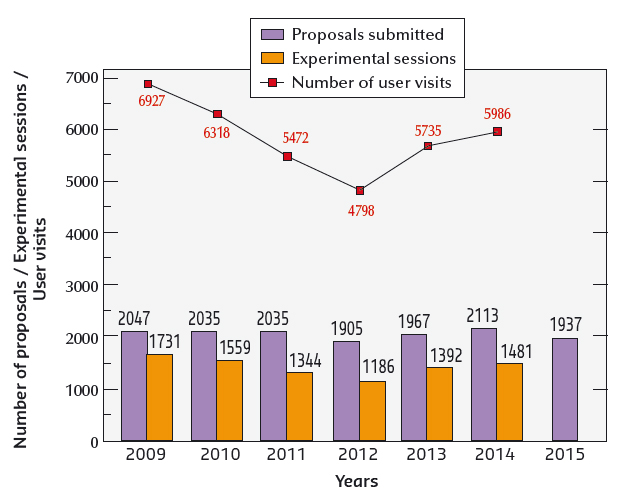 |
|
Fig. 163: Numbers of applications for beamtime, experimental sessions and user visits, 2009 to 2015. N.B. Final numbers of experimental sessions and user visits for 2015 were not available at the time of going to press. |
Proposals for experiments are selected and beamtime allocations are made through peer review. As in previous years, beamtime for 2015 was allocated based on recommendations made by review committees of specialists, for the most part from European countries, Israel and South Africa. These beamline-based committees review all proposals received for a particular beamline. This gives the committees an overview of all the projects proposed for a single beamline, and allows them greater flexibility to optimise the selection of proposals awarded beamtime on each beamline. Proposals for experiments in 2015 were reviewed by 11 review committees grouping the following beamlines of similar techniques or activities:
• C01: ID01, ID03, BM25B, BM32
• C02: ID11, ID22, ID31
• C03: ID12, BM28, ID32
• C04: BM01B, BM08, BM20, BM23, BM25A, BM26A, BM30B
• C05: BM01A, ID06-LVP, ID09A, ID18, ID27, ID28
• C06: ID17, ID19
• C07: ID16A, ID16B, ID21
• C08: ID02, ID13, BM26B
• C09: BM02, ID09B, ID10
• C10: Structural biology beamlines
• C11: ID20, ID24, ID26
The scientific areas of the ESRF research activities reviewed by these eleven Committees are shown in Table 7.
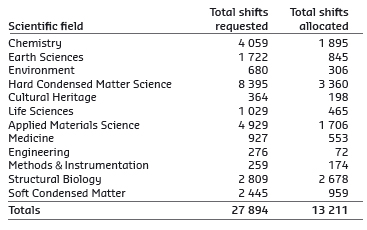 |
|
Table 7: Shifts of beamtime requested and allocated for user experiments, year 2015. |
The review committees met twice during the year, around six weeks after the deadlines for submission of proposals (1 September 2014 and 1 March 2015). They reviewed 1937 applications for beamtime in 2015 and selected 901 (46.5%) in total. This year, the September 2015 deadline date was modified from 1st to 10th September, in a bid to give proposers more time after the summer and conference season to prepare their beamtime proposals. This move was clearly a success as it resulted in a record number of 1135 proposals being submitted for the autumn deadline, the previous highest being 992 proposals back in September 2009.
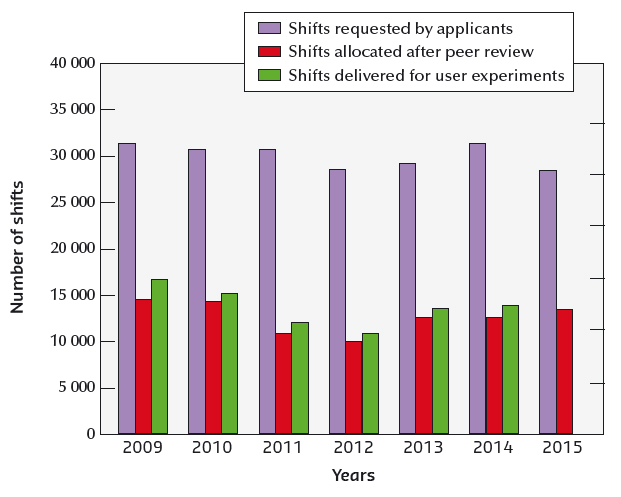 |
|
Fig. 164: Amount of beamtime requested, allocated and delivered, 2009 to 2015. N.B. The final number for beamtime delivered for 2015 was not available at the time of going to press. |
Requests for beamtime in 2015, which is scheduled in shifts of 8 hours, totalled 27 894 shifts or 223 152 hours, of which 13 211 shifts or 105 688 hours (47.4%) were allocated. The distribution of shifts requested and allocated by scientific area for 2015 is shown in Table 7, while the number of shifts requested, allocated and delivered per year since 2009 is shown in Figure 164.
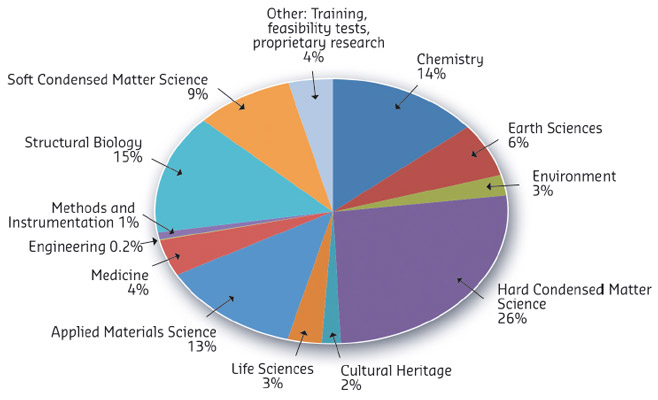 |
|
Fig. 165: Shifts delivered for experiments, March to July 2015, by scientific area, total 6714. |
The breakdown of shifts delivered for experiments by scientific area in the first half of 2015 is shown in Figure 165. This same period saw 2933 visits by scientists to the ESRF under the user programme, to carry out 769 experiments. Overall, the number of users in each experimental team averaged just under 4 persons and the average duration of an experimental session was less than 9 shifts. This can be further broken down to show an average duration of less than 3 shifts for MX experiments and 13.5 shifts for non-MX experiments. The annual number of experimental sessions and user visits since 2009 is shown in Figure 163. Based on beamtime delivered so far in 2015, the number of experiment sessions for the full year is expected to be well in excess of 1600, and the number of user visits is expected to surpass 6300. This brings these figures back to pre-Phase I values, despite the fact that not all beamlines were fully running in 2015. It is therefore expected that the ESRF will next year show a higher level of usage than ever before, despite the permanent closure of two beamlines during 2011.
One of the principle measurable output parameters of the ESRF is the number and quality of publications accepted in peer-reviewed journals. The number of publications rose continuously for many years, eventually reaching a plateau of over 1800 publications per year over the period of the Phase I programme, as shown in Figure 166. These are excellent figures, showing research output maintained at a worldwide high despite a very busy and disruptive upgrade programme. The year 2015 may show the first signs of the expected small drop in output resulting from the 5-month general shutdown of the ESRF back in 2011-2012 and the various beamline closures over the duration of Phase I, with 1650 publications registered so far in the ILL/ESRF Library database which is slightly lower than the 2014 figure at this same time last year. Since the ESRF began user operation back in 1994, a total of 26881 publications have been accepted in peer-reviewed journals. Of these, around 300 every year are published in high impact factor journals.
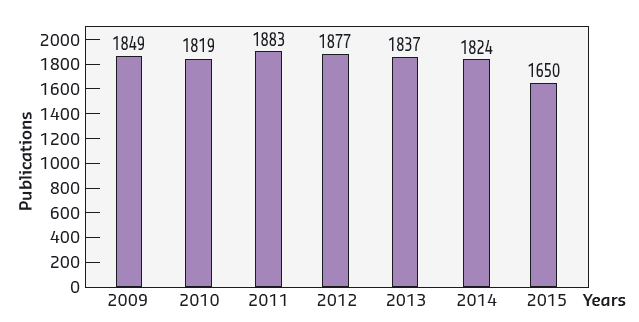 |
|
Fig. 166: Numbers of publications appearing in refereed journals reporting on data collected either partially or totally at the ESRF, 2009 to 2015. |
User responses to questionnaires show once again that the ESRF continues to maintain its excellent reputation concerning the assistance and service given by scientists and support staff at the beamlines, and travel and administrative arrangements, in addition to the quality both of the beam and of the experimental stations. Facilities on site, such as preparation laboratories and collaborative platforms offering complementary techniques and support, the Guesthouse and a canteen open 7 days a week, also make an important contribution to the quality of user support.
Administration and finance
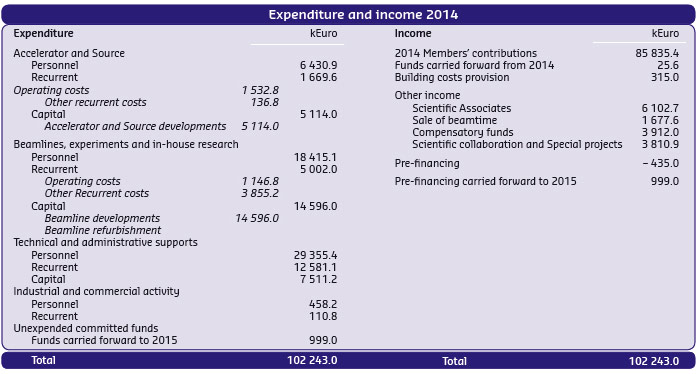 |
|
|
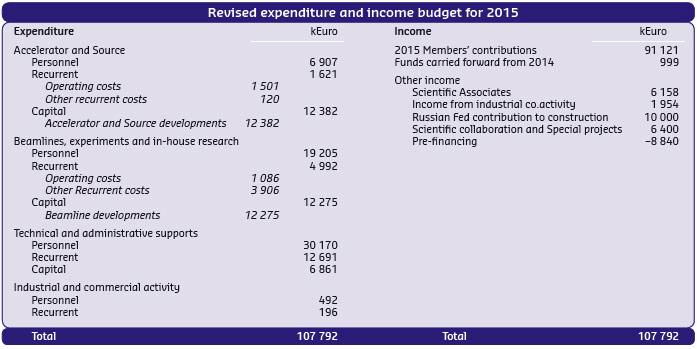 |
|
The budget for 2015 includes additional contributions from Members and Scientific Associates of 16 176 kEUR dedicated to the Upgrade Programme. The Upgrade expenditure budget amounts to a total of 25 041 kEUR including 13 020 kEUR of ESRF operating budget. 2015 is also the first year of the ESRF-EBS project. |
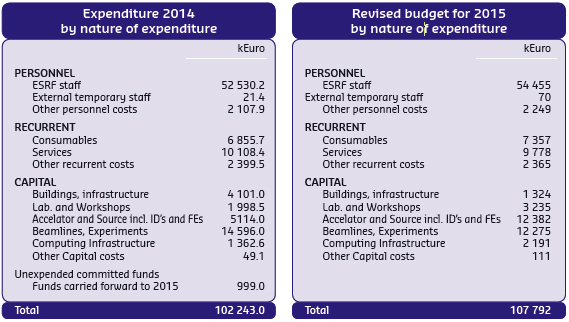 |
|
|
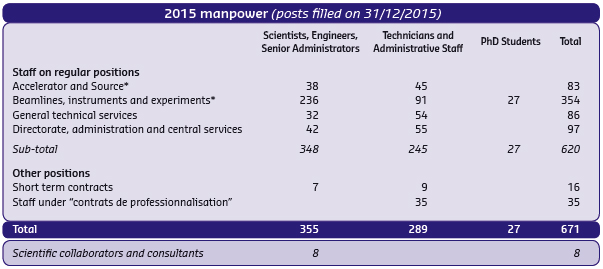 |
|
* Including scientific staff on time limited contracts. |
Organisation chart of the ESRF
(as of January 2016)
 |
|
|



